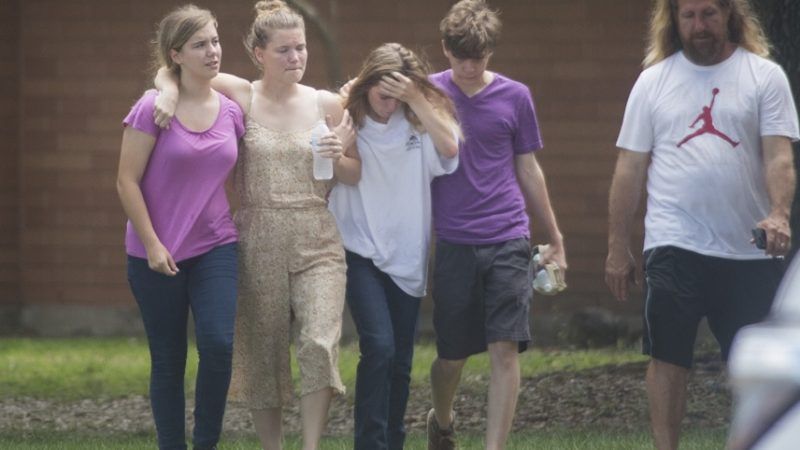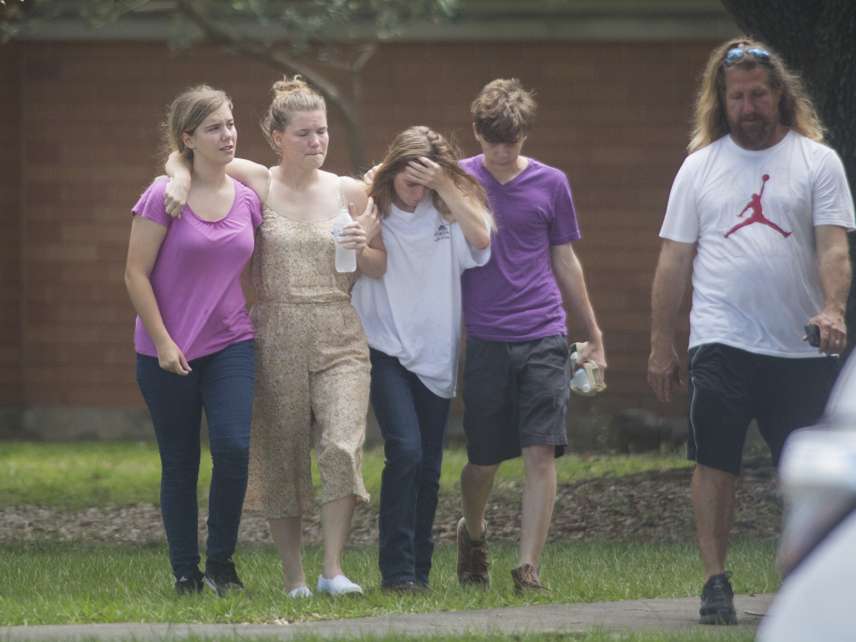What Can Be Done To Stop School Shootings Without Shredding the Constitution?
Probably nothing. Which doesn't mean libertarians shouldn't be having a serious conversation after Santa Fe, Parkland, and other tragedies.


Another week, another school shooting, this time at Texas' Santa Fe High School. Ten people have been killed, 10 wounded, and a suspect and accomplice are in police custody.
What can—and should—be done to reduce or eliminate such horrible events? From a specifically libertarian perspective, this isn't an easy question for at least two reasons.
First, most libertarians are slow to restrict constitutionally protected rights to own and bear arms, especially since it's only been relatively recently (2008) that the Supreme Court has fully recognized an individual right to keep and bear arms (states had been liberalizing gun control for years prior to that). Second, increases in the ability to own and carry weapons under more circumstances have correlated with a massive decrease in violent crime generally, including gun crimes:
From 1993 to 2015, the rate of violent crime declined from 79.8 to 18.6 victimizations per 1,000 persons age 12 or older,' says the Bureau of Justice Statistics in its most recent comprehensive report (published last October, using data through 2015). Over the same period, rates for crimes using guns dropped from 7.3 per 1,000 people to 1.1 per 1,000 people. The homicide rate is down from 7.4 to 4.9. These are not simply good things, they are great things. They are the essential backdrop of all discussions about gun crime and mass shootings….
From a macro-policy perspective, then, things are going in the right direction. People have more rights, more guns, and they are safer, too. The libertarian response to mass shootings, including school shootings, has been to assert the primacy of the Constitution, highlight positive trends, and to point toward other statistics intended to calm public fears. That may not be enough to withstand a number of counter-trends, however, including fears that mass shootings are becoming more common and gun ownership needs to be more-tightly restricted.
Mass shootings, says researcher Grant Duwe, are not getting more common (though, yes, they are getting more violent). "U.S. classrooms safer today than at any time in recent memory." Good guys with guns stop bad guys with guns far, far more often than most people appreciate. Every possible solution—banning certain types of weapons, arming teachers, putting more cops in schools, expanding mental-health background checks, mandating truly universal background checks that would cover even private gun transactions among family members, shrinking the size of magazines, you name it—won't change anything, has been tried already and failed, or won't pass constitutional muster.
In the wake of the Santa Fe shooting, coming after the Parkland shooting that killed 17, one at Central Michigan University that killed two, and one at a Tennessee Waffle House that killed four, anger, confusion, and fear will understandably reign for a good, long time among people on all sides of the gun-control issue. The Parkland shooter, for example, was extremely well-known to police and social services before he unleashed his terror. Even as the on-site Broward County sheriff who refused to confront the killer during the shooting retires on a six-figure annual pension, the school district is stonewalling requests for information from the families of victims, government, and the media. Scot Israel, who runs the Broward County Sheriff Department, said he wasn't responsible for the failure of his officers in the field. It appears that the Santa Fe shooter used what one analyst called "a Wal Mart beginner hunting gun"—a sawed-off shotgun in most accounts, along with a semiautomatic pistol—while on his rampage, confounding the idea that particular weapons are especially lethal.
Tallies of the number of school shooting so far this year range from 42 to 22 to nine, depending on the source and definition used (CNN alone offered up wildly differing totals yesterday). Local and national politicians are already calling for changes to gun laws and calling out the National Rifle Association (NRA), the country's biggest gun group:
'It's time we strip the NRA of its stranglehold over our children's lives.' — Elizabeth Warren is the first U.S. senator to pledge never to take money from the NRA pic.twitter.com/yzKWedNQNb
— NowThis (@nowthisnews) May 18, 2018
New York Gov. Andrew Cuomo has already declared, in all caps, that the time has come to "DO SOMETHING," regardless of efficacy or effectiveness. Such pronouncements will grow in the coming days and make gun owners, who (rightly or wrongly) already feel threatened by politicians who they (rightly or wrongly) invariably call "gun-grabbers," even more worried than usual. Declan McCullagh earlier this week reported that the Supreme Court declined to hear a challenge to county-level zoning law that effectively allows California municipalities to ban gun stores. Over the coming months, expect a hardening of positions between supporters and opponents of the Second Amendment, even as there are reasons to believe that supporters are losing the "culture war over guns." After the Parkland shooting, notes Peter Beinart at The Atlantic,
More than 20 corporations, including United Airlines, Hertz, and MetLife have cut ties with the NRA. Walmart and Dick's Sporting Goods, two of America's largest gun retailers, have both announced they will stop selling guns to people under the age of 21. The Marjory Stoneman Douglas gun-control activists have become national heroes, praised by numerous celebrities.
Even hardcore gun-rights supporters increasingly feel a need to, like Gov. Cuomo, do something. In the aftermath of Parkland, National Review's David French began promoting the idea of "gun violence restraining orders" (GVROs), which would allow family members and law enforcement officials to petition a court to strip individuals of Second Amendment rights. GVROs, warned Jacob Sullum, provide "much potential for abuse by malicious or mistaken petitioners, abetted by judges who will be inclined to err on the side of what they believe to be caution by revoking the Second Amendment rights of possibly dangerous people." In the wake of the Santa Fe shooting, French points to a 2015 piece by journalist Malcolm Gladwell that he calls
the best explanation for modern American mass shootings, and it's easily the least comforting. At the risk of oversimplifying a complex argument, essentially he argues that each mass shooting lowers the threshold for the next. He argues, we are in the midst of a slow-motion "riot" of mass shootings, with the Columbine shooting in many ways the key triggering event.
Gladwell's case isn't immediately convincing to me—Columbine happened 20 years ago and the frequency of mass shootings hasn't increased and gun violence has declined—but that's less important than what people feel is happening. If conservatives as rock-ribbed as David French, a veteran and former head of The Foundation for Individual Rights in Education (FIRE) whom GOP anti-Trumper Bill Kristol unsuccessfully tapped to run against Donald Trump in 2016, are moving in the do-something direction, it's plausible that federal gun-control legislation is only a midterm election away. Donald Trump is nobody's idea of a principled politician. He met with Parkland survivors at the White House and signaled he was open to discussing gun-control legislation and his willingness to do so might become even stronger if the Democrats gain a majority in one or both houses of Congress in the fall. More than anything, the president likes to "win" and make deals, right? Earlier this year, pollsters at the Quinnipiac University National Poll found a historic level of support for "stricter gun laws" (66 percent in favor, 31 percent against) and virtually unanimous support for "universal background checks" (97 percent for, 3 percent against among gun owners). Cuomo's "DO SOMETHING" may be a terrible suggestion, but that doesn't mean it won't carry the day.
Yesterday, the founder of Ars Technica and self-described "gun nut" John Stokes tweeted, "These [shootings] just keep coming, this year. Those of us who value our #2A rights had better come up with something." Along with a long tweetstorm discussing the lethality of the relatively simple weapon reportedly used by the Santa Fe shooter and arguing that "a focus on the 'what' [gun is used] is pointless & should be given up for a focus on the 'who' [that's doing the shooting]," Stokes pointed readers to his April 28 Politico story outlining "gun control that works." An excerpt:
The idea is simple but powerful: a federally issued license for simple possession of all semi-automatic firearms. This license would allow us to carefully vet civilian access to semi-automatic weapons, while overriding state-specific weapon bans and eliminating some of the federal paperwork that ties specific firearms to specific owners.
I offer this idea not only because I actually want to live in a world where it, or something like it, is the law of the land, but also because I and my fellow gun nuts are worried that a storm is coming that will sweep away a substantial portion of our gun rights without really making the country safer in return. We're not even five months into a midterm election year, and 2018 has seen a string of high-profile incidents that have darkened the public's view of civilian gun ownership: February's massacre at Marjory Stoneman Douglas High School in Parkland, Florida, followed by this month's shootings at YouTube headquarters in San Bruno, California, and at a Waffle House in Nashville, Tennessee. In the aftermath of these killings, we're hearing proposals for anti-gun measures that we thought were widely considered out of bounds in the gun control debate, like a ban on all semi-automatic firearms, a repeal of the Second Amendment, or even an outright ban on the private ownership of guns. Some of us think this will all blow over, as it always does. And maybe it will. But this time definitely feels different.
I'm not overly convinced by Stokes' plan any more than I am by David French's call for GVROs or Cuomo's demand that we "DO SOMETHING." But there's a lot of wisdom in Stokes' dictate to "come up with something." A good starting point for famously Vulcan-like libertarians would be to openly acknowledge the pain of survivors and the unspeakable horrors that unfold in locations such as Santa Fe and Parkland. It also makes sense to foreground what is surely common ground with the vast majority of Americans, even "gun-grabbers," which is that we all want a more-peaceful, less-violent America. From there, it is essential to provide arguments and insights that will alleviate rather than inflame concerns about safety, rates of violence, and how guns are used. Conservatives and groups like the NRA are fond of blaming broadly defined "mental illness" for gun violence, along with video games, drug-taking, and Democratic rule in cities such as Chicago. Libertarians should combat those weak arguments and discuss how policies such as the war on drugs intensify and concentrate gun violence in urban communities while also explaining how school, social-service, and law-enforcement authorities routinely shirk their responsibilities to identify and contain true threats (this is perhaps the biggest policy takeaway from Parkland). Reflexively reaching for often-thin arguments simply based on originalism, the Founders' intent, or contempt for any form of gun control isn't going to help very much. "Coming up with something" doesn't need to mean introducing a whole new set of gun laws. It can also mean having meaningful, informed, empathetic conversations with people on the other side of a particularly controversial and fraught issue.
Related video: "5 Facts About Guns, Schools, & Violence," which was released in December 2013 after the Sandy Hook Elementary School shooting in Connecticut. For more details, go here.




Show Comments (445)